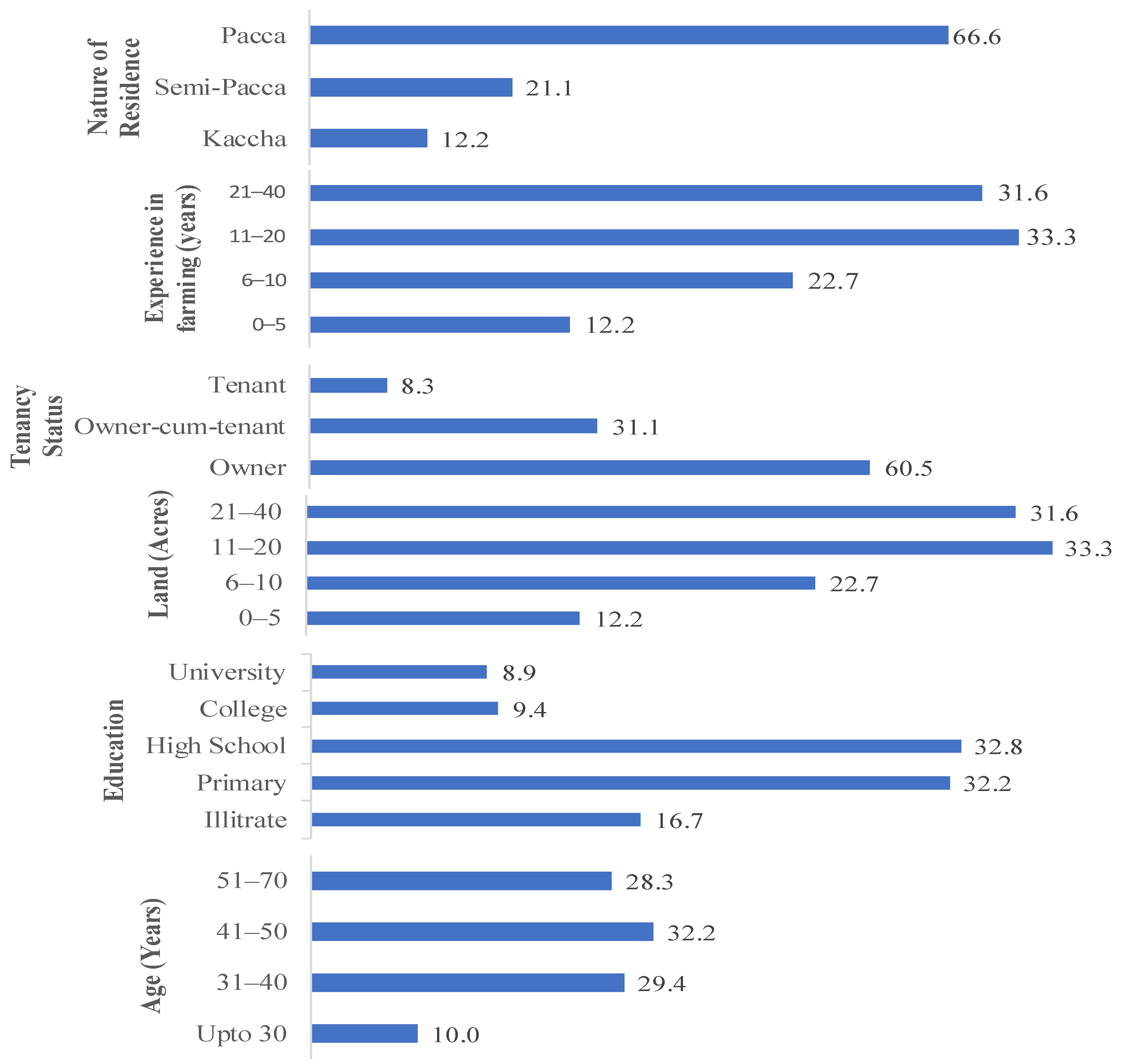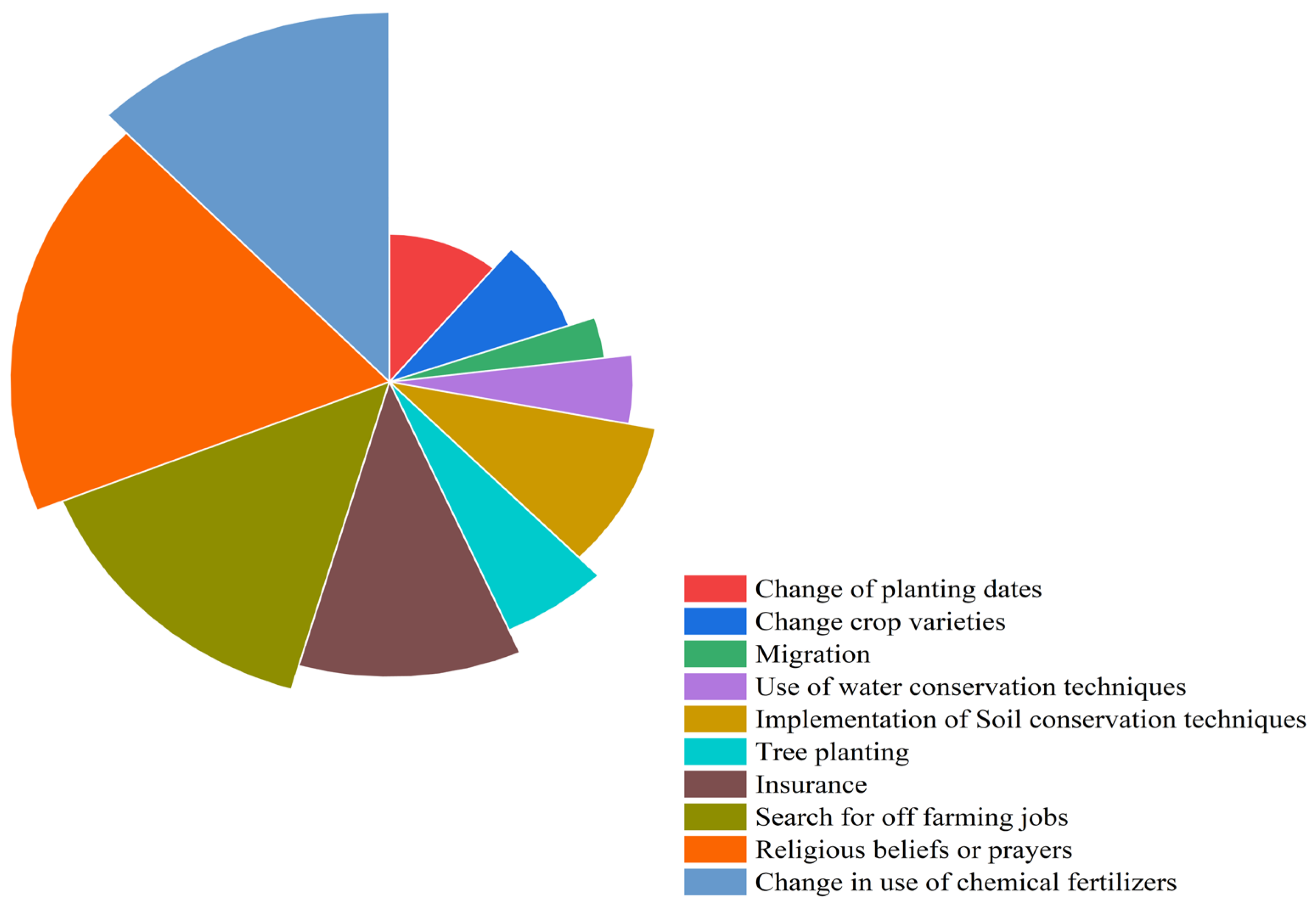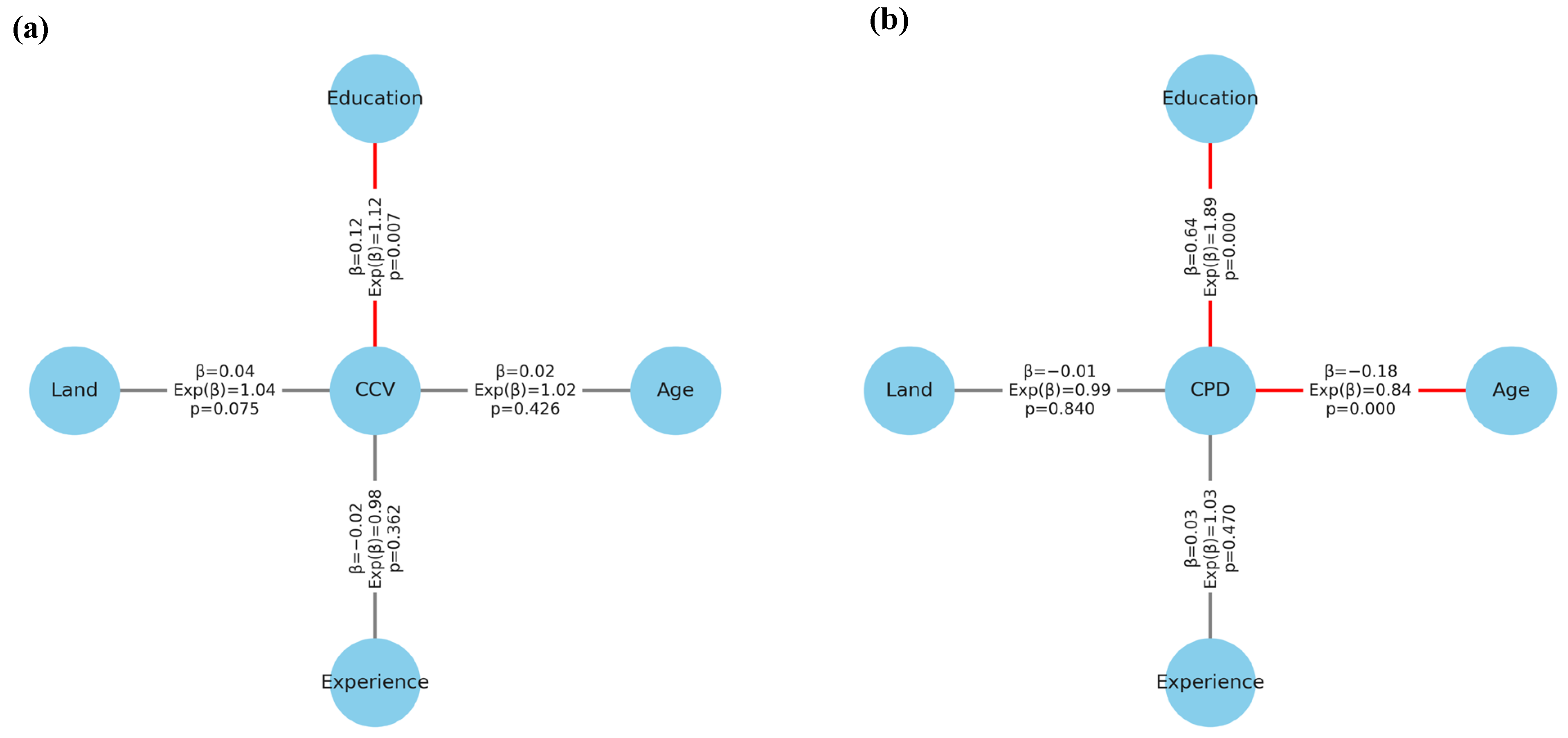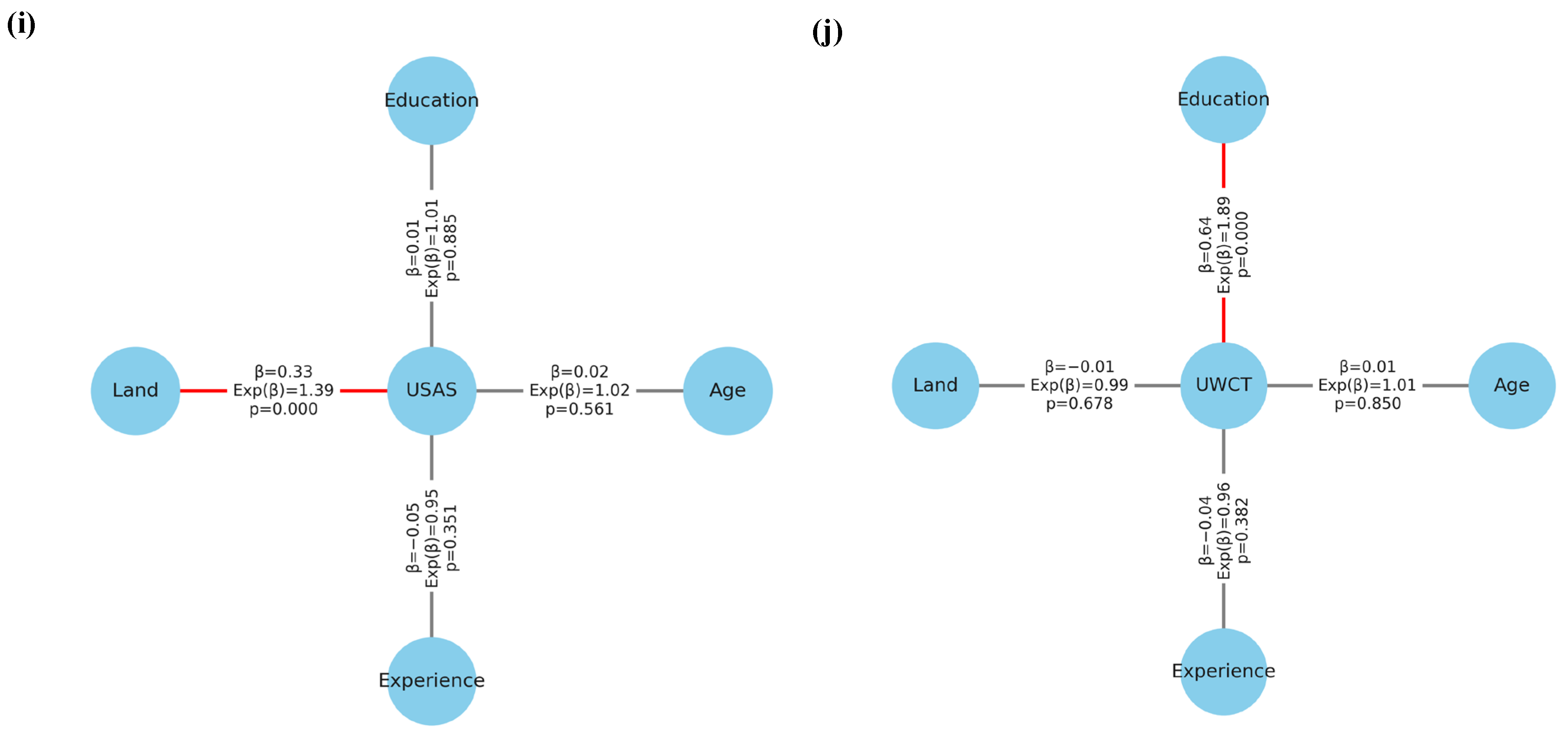Adapting Harvests: A Comprehensive Study of Farmers’ Perceptions, Adaptation Strategies, and Climatic Trends in Dera Ghazi Khan, Pakistan
Abstract
:1. Introduction
2. Materials and Methods
2.1. Study Area
2.2. Data Collection
2.2.1. Climate Data
2.2.2. Survey Data
- Selection of the District Dera Ghazi Khan, Punjab, Pakistan as the study area.
- Selection of two tehsils, D.G. Khan and Taunsa (sub-administrative unit), from the study area.
- Selection of three union councils (smallest administrative unit in the country) from each chosen tehsil.
- Selection of three villages from each chosen union council using simple random sampling.
- A sample of 10 farmers from each village was taken randomly for interview.
2.3. Data Analysis
2.3.1. Descriptive Statistics
2.3.2. Mann–Kendall Trend Test
2.3.3. Ordinal Logistic Regression
2.3.4. Binary Logistic Regression
3. Results
3.1. Climate Change Trends
3.2. Demographic Characteristics of Farmers
3.3. Farmers’ Perceptions of Climate Change
3.4. Socio-Economic Factors Affecting Farmers’ Perceptions Regarding Climate Change
3.5. Climate Change Effects on Farmer’s Life and Income Sources
3.6. Farmer’s Adaptation Strategies to Climate Change
3.7. Factors Affecting Farmers’ Adaptation Strategies
4. Discussion
5. Conclusions and Implications
Author Contributions
Funding
Institutional Review Board Statement
Informed Consent Statement
Data Availability Statement
Conflicts of Interest
References
- Lobell, D.B.; Schlenker, W.; Costa-Roberts, J. Climate trends and global crop production since 1980. Science 2011, 333, 616–620. [Google Scholar] [CrossRef] [PubMed]
- Schmidhuber, J.; Tubiello, F.N. Global food security under climate change. Proc. Natl. Acad. Sci. USA 2007, 104, 19703–19708. [Google Scholar] [CrossRef]
- Zeleke, T.; Beyene, F.; Deressa, T.; Yousuf, J.; Kebede, T. Vulnerability of Smallholder Farmers to Climate Change-Induced Shocks in East Hararghe Zone, Ethiopia. Sustainability 2021, 13, 2162. [Google Scholar] [CrossRef]
- Arsene, M.B.; Nkulu Mwine Fyama, J. Potential threats to agricultural food production and farmers’ coping strategies in the marshlands of Kabare in the Democratic Republic of Congo. Cogent Food Agric. 2021, 7, 1933747. [Google Scholar] [CrossRef]
- Eckstein, D.; Künzel, V.; Schäfer, L. The Global Climate Risk Index 2021; Germanwatch: Bonn, Germany, 2021. [Google Scholar]
- Aslam, A.Q.; Ahmad, S.R.; Ahmad, I.; Hussain, Y.; Hussain, M.S. Vulnerability and impact assessment of extreme climatic event: A case study of southern Punjab, Pakistan. Sci. Total Environ. 2017, 580, 468–481. [Google Scholar] [CrossRef] [PubMed]
- Qamer, F.M.; Abbas, S.; Ahmad, B.; Hussain, A.; Salman, A.; Muhammad, S.; Nawaz, M.; Shrestha, S.; Iqbal, B.; Thapa, S. A framework for multi-sensor satellite data to evaluate crop production losses: The case study of 2022 Pakistan floods. Sci. Rep. 2023, 13, 4240. [Google Scholar] [CrossRef] [PubMed]
- Government of Pakistan. Pakistan Economic Survey 2022–23; Finance and Economic Affairs Division, Ministry of Finance, Government of Pakistan: Islamabad, Pakistan, 2023.
- Füssel, H.-M.; Klein, R.J.T. Climate Change Vulnerability Assessments: An Evolution of Conceptual Thinking. Clim. Change 2006, 75, 301–329. [Google Scholar] [CrossRef]
- Nelson, E.; Mendoza, G.; Regetz, J.; Polasky, S.; Tallis, H.; Cameron, D.; Chan, K.M.; Daily, G.C.; Goldstein, J.; Kareiva, P.M.; et al. Modeling multiple ecosystem services, biodiversity conservation, commodity production, and tradeoffs at landscape scales. Front. Ecol. Environ. 2009, 7, 4–11. [Google Scholar] [CrossRef]
- Robinson, S.-A. Climate change adaptation in SIDS: A systematic review of the literature pre and post the IPCC Fifth Assessment Report. WIREs Clim. Change 2020, 11, e653. [Google Scholar] [CrossRef]
- Grothmann, T.; Patt, A. Adaptive capacity and human cognition: The process of individual adaptation to climate change. Glob. Environ. Change 2005, 15, 199–213. [Google Scholar] [CrossRef]
- Gbetibouo, G.A.; Hassan, R.M.; Ringler, C. Modelling farmers’ adaptation strategies for climate change and variability: The case of the Limpopo Basin, South Africa. Agrekon 2010, 49, 217–234. [Google Scholar] [CrossRef]
- Deressa, T.T.; Hassan, R.M.; Ringler, C. Perception of and adaptation to climate change by farmers in the Nile basin of Ethiopia. J. Agric. Sci. 2011, 149, 23–31. [Google Scholar] [CrossRef]
- Below, T.B.; Mutabazi, K.D.; Kirschke, D.; Franke, C.; Sieber, S.; Siebert, R.; Tscherning, K. Can farmers’ adaptation to climate change be explained by socio-economic household-level variables? Glob. Environ. Change 2012, 22, 223–235. [Google Scholar] [CrossRef]
- Marie, M.; Yirga, F.; Haile, M.; Tquabo, F. Farmers’ choices and factors affecting adoption of climate change adaptation strategies: Evidence from northwestern Ethiopia. Heliyon 2020, 6, e03867. [Google Scholar] [CrossRef]
- Wheeler, S.; Zuo, A.; Bjornlund, H. Farmers’ climate change beliefs and adaptation strategies for a water scarce future in Australia. Glob. Environ. Change 2013, 23, 537–547. [Google Scholar] [CrossRef]
- Menike, L.M.C.S.; Arachchi, K.A.G.P.K. Adaptation to Climate Change by Smallholder Farmers in Rural Communities: Evidence from Sri Lanka. Procedia Food Sci. 2016, 6, 288–292. [Google Scholar] [CrossRef]
- Tesfaye, W.; Seifu, L. Climate change perception and choice of adaptation strategies. Int. J. Clim. Change Strateg. Manag. 2016, 8, 253–270. [Google Scholar] [CrossRef]
- Usman, M.; Ali, A.; Bashir, M.K.; Radulescu, M.; Mushtaq, K.; Wudil, A.H.; Baig, S.A.; Akram, R. Do farmers’ risk perception, adaptation strategies, and their determinants benefit towards climate change? Implications for agriculture sector of Punjab, Pakistan. Environ. Sci. Pollut. Res. 2023, 30, 79861–79882. [Google Scholar] [CrossRef] [PubMed]
- Ahmad, D.; Afzal, M. Climate change adaptation impact on cash crop productivity and income in Punjab province of Pakistan. Environ. Sci. Pollut. Res. 2020, 27, 30767–30777. [Google Scholar] [CrossRef]
- Government of Punjab. Climate of Dera Ghazi Khan. Available online: https://dgkhan.punjab.gov.pk/climate (accessed on 5 May 2023).
- Saleem, M.; Arfan, M.; Ansari, K.; Hassan, D. Analyzing the Impact of Ungauged Hill Torrents on the Riverine Floods of the River Indus: A Case Study of Koh E Suleiman Mountains in the DG Khan and Rajanpur Districts of Pakistan. Resources 2023, 12, 26. [Google Scholar] [CrossRef]
- Mahmood, N.; Arshad, M.; Mehmood, Y.; Faisal Shahzad, M.; Kächele, H. Farmers’ perceptions and role of institutional arrangements in climate change adaptation: Insights from rainfed Pakistan. Clim. Risk Manag. 2021, 32, 100288. [Google Scholar] [CrossRef]
- Visschers, V.H.M. Public Perception of Uncertainties Within Climate Change Science. Risk Anal. 2018, 38, 43–55. [Google Scholar] [CrossRef] [PubMed]
- Pohlert, T. Non-Parametric Trend Tests and Change-Point Detection. CRAN Repository. 2016. Available online: https://CRAN.R-project.org/package=trend (accessed on 5 May 2023).
- Prokopy, L.S.; Arbuckle, J.G.; Barnes, A.P.; Haden, V.R.; Hogan, A.; Niles, M.T.; Tyndall, J. Farmers and Climate Change: A Cross-National Comparison of Beliefs and Risk Perceptions in High-Income Countries. Environ. Manag. 2015, 56, 492–504. [Google Scholar] [CrossRef] [PubMed]
- Robitzsch, A. Why Ordinal Variables Can (Almost) Always Be Treated as Continuous Variables: Clarifying Assumptions of Robust Continuous and Ordinal Factor Analysis Estimation Methods. Front. Educ. 2020, 5, 589965. [Google Scholar] [CrossRef]
- Abid, M.; Scheffran, J.; Schneider, U.A.; Ashfaq, M. Farmers’ perceptions of and adaptation strategies to climate change and their determinants: The case of Punjab province, Pakistan. Earth Syst. Dynam. 2015, 6, 225–243. [Google Scholar] [CrossRef]
- Ayanlade, A.; Radeny, M.; Morton, J.F. Comparing smallholder farmers’ perception of climate change with meteorological data: A case study from southwestern Nigeria. Weather Clim. Extrem. 2017, 15, 24–33. [Google Scholar] [CrossRef]
- Pakistan Meteorological Department. Pakistan’s Monthly Climate Summary: August 2022; Pakistan Meteorological Department: Islamabad, Pakistan, 2022.
- Iqbal, S.; Khan, A.N.; Jadoon, M.A.; Alam, I. Effects of Flood-2010 on Agricultural Sector in Khyber Pakhtunkhwa: A Case of District Charsadda. Sarhad J. Agric. 2018, 34, 1–224. [Google Scholar] [CrossRef]
- Douxchamps, S.; Van Wijk, M.T.; Silvestri, S.; Moussa, A.S.; Quiros, C.; Ndour, N.Y.B.; Buah, S.; Somé, L.; Herrero, M.; Kristjanson, P.; et al. Linking agricultural adaptation strategies, food security and vulnerability: Evidence from West Africa. Reg. Environ. Change 2016, 16, 1305–1317. [Google Scholar] [CrossRef]
- Kosoe, E.A.; Ahmed, A. Climate change adaptation strategies of cocoa farmers in the Wassa East District: Implications for climate services in Ghana. Clim. Serv. 2022, 26, 100289. [Google Scholar] [CrossRef]
- Wang, D.; Hejazi, M.; Cai, X.; Valocchi, A.J. Climate change impact on meteorological, agricultural, and hydrological drought in central Illinois. Water Resour. Res. 2011, 47, W09527. [Google Scholar] [CrossRef]
- Church, S.P.; Dunn, M.; Babin, N.; Mase, A.S.; Haigh, T.; Prokopy, L.S. Do advisors perceive climate change as an agricultural risk? An in-depth examination of Midwestern U.S. Ag advisors’ views on drought, climate change, and risk management. Agric. Hum. Values 2018, 35, 349–365. [Google Scholar] [CrossRef]
- Nam, W.-H.; Choi, J.-Y.; Hong, E.-M. Irrigation vulnerability assessment on agricultural water supply risk for adaptive management of climate change in South Korea. Agric. Water Manag. 2015, 152, 173–187. [Google Scholar] [CrossRef]
- Iglesias, A.; Garrote, L. Adaptation strategies for agricultural water management under climate change in Europe. Agric. Water Manag. 2015, 155, 113–124. [Google Scholar] [CrossRef]
- Bhattacharyya, P.; Pathak, H.; Pal, S. Water Management for Climate-Smart Agriculture. In Climate Smart Agriculture: Concepts, Challenges, and Opportunities; Bhattacharyya, P., Pathak, H., Pal, S., Eds.; Springer: Singapore, 2020; pp. 57–72. [Google Scholar]
- Abid, M.; Scheffran, J.; Schneider, U.A.; Elahi, E. Farmer Perceptions of Climate Change, Observed Trends and Adaptation of Agriculture in Pakistan. Environ. Manag. 2019, 63, 110–123. [Google Scholar] [CrossRef]
- Amir, S.; Saqib, Z.; Khan, M.I.; Ali, A.; Khan, M.A.; Bokhari, S.A.; Zaman ul, H. Determinants of farmers’ adaptation to climate change in rain-fed agriculture of Pakistan. Arab. J. Geosci. 2020, 13, 1025. [Google Scholar] [CrossRef]
- Debaeke, P.; Pellerin, S.; Scopel, E. Climate-smart cropping systems for temperate and tropical agriculture: Mitigation, adaptation and trade-offs. Cah. Agric. 2017, 26, 34002. [Google Scholar] [CrossRef]
- Atube, F.; Malinga, G.M.; Nyeko, M.; Okello, D.M.; Alarakol, S.P.; Okello-Uma, I. Determinants of smallholder farmers’ adaptation strategies to the effects of climate change: Evidence from northern Uganda. Agric. Food Secur. 2021, 10, 6. [Google Scholar] [CrossRef]
- Deressa, T.T.; Hassan, R.M.; Ringler, C.; Alemu, T.; Yesuf, M. Determinants of farmers’ choice of adaptation methods to climate change in the Nile Basin of Ethiopia. Glob. Environ. Change 2009, 19, 248–255. [Google Scholar] [CrossRef]
- Suarez, P.; Linnerooth-Bayer, J.; Mechler, R. Feasibility of Risk Financing Schemes for Climate Adaptation: The Case of Malawi; World Bank: Washington, DC, USA, 2007. [Google Scholar]
- Gebru, G.W.; Ichoku, H.E.; Phil-Eze, P.O. Determinants of smallholder farmers’ adoption of adaptation strategies to climate change in Eastern Tigray National Regional State of Ethiopia. Heliyon 2020, 6, e04356. [Google Scholar] [CrossRef]
- Ashraf, M.; Routray, J.K.; Saeed, M. Determinants of farmers’ choice of coping and adaptation measures to the drought hazard in northwest Balochistan, Pakistan. Nat. Hazards 2014, 73, 1451–1473. [Google Scholar] [CrossRef]
- Asfaw, S.; McCarthy, N.; Lipper, L.; Arslan, A.; Cattaneo, A. What determines farmers’ adaptive capacity? Empirical evidence from Malawi. Food Secur. 2016, 8, 643–664. [Google Scholar] [CrossRef]
- Trinh, T.Q.; Rañola, R.F.; Camacho, L.D.; Simelton, E. Determinants of farmers’ adaptation to climate change in agricultural production in the central region of Vietnam. Land Use Policy 2018, 70, 224–231. [Google Scholar] [CrossRef]
- Salvatore Di, F.; Marcella, V. How Can African Agriculture Adapt to Climate Change? A Counterfactual Analysis from Ethiopia. Land Econ. 2013, 89, 743. [Google Scholar] [CrossRef]
- Barnett, J.; O’neill, S. maladaptation. Glob. Environ. Change 2010, 20, 211–213. [Google Scholar] [CrossRef]
- Hussain, S.S.; Mudasser, M. Prospects for wheat production under changing climate in mountain areas of Pakistan—An econometric analysis. Agric. Syst. 2007, 94, 494–501. [Google Scholar] [CrossRef]
- Atta ur, R.; Khan, A.N. Analysis of flood causes and associated socio-economic damages in the Hindukush region. Nat. Hazards 2011, 59, 1239–1260. [Google Scholar] [CrossRef]
- Ahmad, H.; Öztürk, M.; Ahmad, W.; Khan, S.M. Status of Natural Resources in the Uplands of the Swat Valley Pakistan. In Climate Change Impacts on High-Altitude Ecosystems; Öztürk, M., Hakeem, K.R., Faridah-Hanum, I., Efe, R., Eds.; Springer International Publishing: Cham, Switzerland, 2015; pp. 49–98. [Google Scholar]
- Raza, A.; Ahrends, H.; Habib-Ur-Rahman, M.; Gaiser, T. Modeling Approaches to Assess Soil Erosion by Water at the Field Scale with Special Emphasis on Heterogeneity of Soils and Crops. Land 2021, 10, 422. [Google Scholar] [CrossRef]
- Shah, A.A.; Shaw, R.; Ye, J.; Abid, M.; Amir, S.M.; Kanak Pervez, A.K.M.; Naz, S. Current capacities, preparedness and needs of local institutions in dealing with disaster risk reduction in Khyber Pakhtunkhwa, Pakistan. Int. J. Disaster Risk Reduct. 2019, 34, 165–172. [Google Scholar] [CrossRef]
- Mamun, A.A.; Roy, S.; Islam, A.R.M.T.; Alam, G.M.M.; Alam, E.; Chandra Pal, S.; Sattar, M.A.; Mallick, J. Smallholder Farmers’ Perceived Climate-Related Risk, Impact, and Their Choices of Sustainable Adaptation Strategies. Sustainability 2021, 13, 11922. [Google Scholar] [CrossRef]
- Saeed Khan, K. Analysing local perceptions of post-conflict and post-floods livelihood interventions in Swat, Pakistan. Dev. Policy Rev. 2019, 37, O274–O292. [Google Scholar] [CrossRef]
- Ali, A.; Rana, I.A.; Ali, A.; Najam, F.A. Flood risk perception and communication: The role of hazard proximity. J. Environ. Manag. 2022, 316, 115309. [Google Scholar] [CrossRef] [PubMed]
- Bergmann, S. Climate Change Changes Religion. Stud. Theol. Nord. J. Theol. 2009, 63, 98–118. [Google Scholar] [CrossRef]
- Hulme, M. Climate Change and the Significance of Religion. Econ. Political Wkly. 2017, 52, 14–17. [Google Scholar]
- Rahman, M.H.U.; Ahmad, A.; Wang, X.; Wajid, A.; Nasim, W.; Hussain, M.; Ahmad, B.; Ahmad, I.; Ali, Z.; Ishaque, W.; et al. Multi-model projections of future climate and climate change impacts uncertainty assessment for cotton production in Pakistan. Agric. For. Meteorol. 2018, 253–254, 94–113. [Google Scholar] [CrossRef]
- Amin, A.; Nasim, W.; Mubeen, M.; Ahmad, A.; Nadeem, M.; Urich, P.; Fahad, S.; Ahmad, S.; Wajid, A.; Tabassum, F.; et al. Simulated CSM-CROPGRO-cotton yield under projected future climate by SimCLIM for southern Punjab, Pakistan. Agric. Syst. 2018, 167, 213–222. [Google Scholar] [CrossRef]
- Anser, M.K.; Hina, T.; Hameed, S.; Nasir, M.H.; Ahmad, I.; Naseer, M.A.U.R. Modeling Adaptation Strategies against Climate Change Impacts in Integrated Rice-Wheat Agricultural Production System of Pakistan. Int. J. Environ. Res. Public Health 2020, 17, 2522. [Google Scholar] [CrossRef]
- Ali, M.F.; Rose, S. Farmers’ perception and adaptations to climate change: Findings from three agro-ecological zones of Punjab, Pakistan. Environ. Sci. Pollut. Res. 2021, 28, 14844–14853. [Google Scholar] [CrossRef]
- Shahid, R.; Shijie, L.; Shahid, S.; Altaf, M.A.; Shahid, H. Determinants of reactive adaptations to climate change in semi-arid region of Pakistan. J. Arid Environ. 2021, 193, 104580. [Google Scholar] [CrossRef]
- Dang, H.L.; Li, E.; Nuberg, I.; Bruwer, J. Factors influencing the adaptation of farmers in response to climate change: A review. Clim. Dev. 2019, 11, 765–774. [Google Scholar] [CrossRef]
- Ojo, T.O.; Baiyegunhi, L.J.S. Determinants of climate change adaptation strategies and its impact on the net farm income of rice farmers in south-west Nigeria. Land Use Policy 2020, 95, 103946. [Google Scholar] [CrossRef]
- Thinda, K.T.; Ogundeji, A.A.; Belle, J.A.; Ojo, T.O. Understanding the adoption of climate change adaptation strategies among smallholder farmers: Evidence from land reform beneficiaries in South Africa. Land Use Policy 2020, 99, 104858. [Google Scholar] [CrossRef]
- Kibue, G.W.; Pan, G.; Joseph, S.; Xiaoyu, L.; Jufeng, Z.; Zhang, X.; Li, L. More than two decades of climate change alarm: Farmers knowledge, attitudes and perceptions. Afr. J. Agric. Res. 2015, 10, 2617–2625. [Google Scholar]
- Bryan, E.; Ringler, C.; Okoba, B.; Roncoli, C.; Silvestri, S.; Herrero, M. Adapting agriculture to climate change in Kenya: Household strategies and determinants. J. Environ. Manag. 2013, 114, 26–35. [Google Scholar] [CrossRef] [PubMed]
- Sardar, A.; Kiani, A.K.; Kuslu, Y. Does adoption of climate-smart agriculture (CSA) practices improve farmers’ crop income? Assessing the determinants and its impacts in Punjab province, Pakistan. Environ. Dev. Sustain. 2021, 23, 10119–10140. [Google Scholar] [CrossRef]
- Jamil, I.; Jun, W.; Mughal, B.; Waheed, J.; Hussain, H.; Waseem, M. Agricultural Innovation: A comparative analysis of economic benefits gained by farmers under climate resilient and conventional agricultural practices. Land Use Policy 2021, 108, 105581. [Google Scholar] [CrossRef]
- Gifford, R. The dragons of inaction: Psychological barriers that limit climate change mitigation and adaptation. Am. Psychol. 2011, 66, 290–302. [Google Scholar] [CrossRef] [PubMed]
- McNeeley, S.M.; Lazrus, H. The Cultural Theory of Risk for Climate Change Adaptation. Weather Clim. Soc. 2014, 6, 506–519. [Google Scholar] [CrossRef]
- Khatri-Chhetri, A.; Aggarwal, P.K.; Joshi, P.K.; Vyas, S. Farmers’ prioritization of climate-smart agriculture (CSA) technologies. Agric. Syst. 2017, 151, 184–191. [Google Scholar] [CrossRef]









| Variable Name | Variable Description |
|---|---|
| Dependent Variables (Ordinal) | |
| Perceived weather uncertainty | Likert Scale: ranges from 1 (Very low) to 5 (Very High) |
| Perceived pollution | Likert Scale: ranges from 1 (Very low) to 5 (Very High) |
| Perceived soil erosion | Likert Scale: ranges from 1 (Very low) to 5 (Very High) |
| Perceived floods | Likert Scale: ranges from 1 (Very low) to 5 (Very High) |
| Perceived heatwave | Likert Scale: ranges from 1 (Very low) to 5 (Very High) |
| Perceived rain | Likert Scale: ranges from 1 (Very low) to 5 (Very High) |
| Perceived drought | Likert Scale: ranges from 1 (Very low) to 5 (Very High) |
| Dependent Variables (Logit) | |
| Change in planting dates | 1 = Adopted, 0 = Not adopted |
| Change crop varieties | 1 = Adopted, 0 = Not adopted |
| Use of water conservation techniques | 1 = Adopted, 0 = Not adopted |
| Implementation of soil conservation techniques | 1 = Adopted, 0 = Not adopted |
| Use of shades and shelters | 1 = Adopted, 0 = Not adopted |
| Migration | 1 = Adopted, 0 = Not adopted |
| Insurance | 1 = Adopted, 0 = Not adopted |
| Search for off-farming jobs | 1 = Adopted, 0 = Not adopted |
| Religious beliefs or prayers | 1 = Adopted, 0 = Not adopted |
| Change the use of chemical fertilizers, pesticides, and insecticides | 1 = Adopted, 0 = Not adopted |
| Independent Variables | |
| Age | Continuous |
| Education | Continuous |
| Land in acres | Continuous |
| Experience | Continuous |
| Climatic Parameters | Sum of Ranks | Kendall’s Tau | p-Value (Two-Tailed) | Var (S) | Sen’s Slope | Hypothesis |
|---|---|---|---|---|---|---|
| Annual Rainfall | 64 | 0.337 | 0.041 | 950 | 6.592 | Ha Accept |
| Annual Maximum Temperature | 1 | 0.005 | 1.000 | 933 | 0 | Ho Accept |
| Annual Minimum Temperature | −66 | −0.357 | 0.034 | 938.6 | −0.065 | Ha Accept |
| Environmental Issues | Perception (%) | Mean | ||||
|---|---|---|---|---|---|---|
| Very Low | Low | Moderate | High | Very High | ||
| Weather Uncertainty | 15.0 | 27.8 | 27.2 | 22.2 | 7.8 | 2.80 |
| Floods | 3.3 | 24.4 | 38.9 | 27.8 | 5.6 | 3.07 |
| Rain | 1.1 | 15.6 | 28.3 | 43.9 | 11.1 | 3.48 |
| Drought | 7.8 | 32.8 | 37.2 | 20.6 | 1.7 | 2.75 |
| Heat waves | 9.4 | 29.4 | 35.0 | 21.1 | 5.0 | 2.82 |
| Soil erosion | 25.6 | 22.8 | 28.3 | 18.9 | 4.4 | 2.53 |
| Variables | Perceived Weather Uncertainty | Perceived Rain | Perceived Soil Erosion | Perceived Floods | Perceived Heatwave | Perceived Drought | ||||||
|---|---|---|---|---|---|---|---|---|---|---|---|---|
| Estimate | OR | Estimate | OR | Estimate | OR | Estimate | OR | Estimate | OR | Estimate | OR | |
| Age | −0.017 ** | 0.984 | 0.007 ** | 1.007 | −0.026 ** | 0.974 | 0.006 ** | 1.006 | −0.193 * | 0.825 | −0.031 ** | 0.969 |
| Education | 0.226 * | 1.254 | 0.180 * | 1.197 | 0.109 * | 1.115 | 0.326 * | 1.386 | 0.272 * | 1.313 | 0.220 * | 1.246 |
| Land | −0.016 ** | 0.984 | 0.002 ** | 1.002 | 0.279 * | 1.321 | 0.117 * | 1.124 | 0.000 ** | 1.000 | 0.005 ** | 1.005 |
| Experience in farming | −0.012 ** | 0.988 | −0.066 * | 0.936 | −0.012 ** | 0.988 | 0.041 * | 1.042 | 0.025 ** | 1.025 | 0.072 * | 1.075 |
Disclaimer/Publisher’s Note: The statements, opinions and data contained in all publications are solely those of the individual author(s) and contributor(s) and not of MDPI and/or the editor(s). MDPI and/or the editor(s) disclaim responsibility for any injury to people or property resulting from any ideas, methods, instructions or products referred to in the content. |
© 2024 by the authors. Licensee MDPI, Basel, Switzerland. This article is an open access article distributed under the terms and conditions of the Creative Commons Attribution (CC BY) license (https://creativecommons.org/licenses/by/4.0/).
Share and Cite
Shah, S.A.A.; Mehmood, M.S.; Muhammad, I.; Ahamad, M.I.; Wu, H. Adapting Harvests: A Comprehensive Study of Farmers’ Perceptions, Adaptation Strategies, and Climatic Trends in Dera Ghazi Khan, Pakistan. Sustainability 2024, 16, 7070. https://doi.org/10.3390/su16167070
Shah SAA, Mehmood MS, Muhammad I, Ahamad MI, Wu H. Adapting Harvests: A Comprehensive Study of Farmers’ Perceptions, Adaptation Strategies, and Climatic Trends in Dera Ghazi Khan, Pakistan. Sustainability. 2024; 16(16):7070. https://doi.org/10.3390/su16167070
Chicago/Turabian StyleShah, Syed Ali Asghar, Muhammad Sajid Mehmood, Ihsan Muhammad, Muhammad Irfan Ahamad, and Huixin Wu. 2024. "Adapting Harvests: A Comprehensive Study of Farmers’ Perceptions, Adaptation Strategies, and Climatic Trends in Dera Ghazi Khan, Pakistan" Sustainability 16, no. 16: 7070. https://doi.org/10.3390/su16167070
APA StyleShah, S. A. A., Mehmood, M. S., Muhammad, I., Ahamad, M. I., & Wu, H. (2024). Adapting Harvests: A Comprehensive Study of Farmers’ Perceptions, Adaptation Strategies, and Climatic Trends in Dera Ghazi Khan, Pakistan. Sustainability, 16(16), 7070. https://doi.org/10.3390/su16167070






